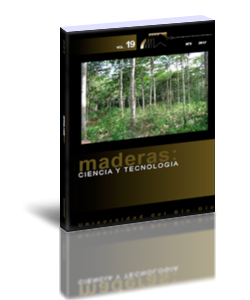Effect of the anatomical structure, wood properties and machining conditions on surface roughness of wood
Keywords:
Fagus sylvatica, hardness, Pinus sylvestris, Quercus alba, roughness.Abstract
The main aim is to test the influence of anatomical structure (grain direction and elements size), wood hardness and machining conditions on wood surface roughness. 180 samples defect-free were obtained from beech, oak and pine and processed with different machining methods (planning, sanding with 60 grit or sanding with 180 grit). Roughness, hardness, and anatomical structure were analysed using international methodologies. An analysis of variance of the data from all the samples with the four factors in the experimental design were performed. Results showed that machining processes and species are the factors that significantly affect surface roughness, as opposed to grain direction (plane of section and stylus-grain angle), which was only shown to be significant in some subgroups. Roughness parameters of samples sanded with 180 grit were lower in contrast to samples planned or sanded with 60 grit. Hardness was found to be the property of the wood that most clearly affects its final roughness, and makes it difficult to achieve better roughness results as the hardness increases.Downloads
References
Aguilera, A.; Muñoz, H. 2011. Rugosidad superficial y potencia de corte en el cepillado de Acacia melanoxylon y Sequoia sempervirens. Maderas.Ciencia y Tecnología 13 (1):19-28.
Gurau, L.; Mansfield-Williams, H.; Irle, M. 2007. Separation of processing roughness from anatomical irregularities and fuzziness to evaluate the effect of grit size on sanded european oak. Forest Products Journal 57 (1/2):110.
Gurau, L.; Mansfield-Williams, H.; Irle, M. 2005. The influence of wood anatomy on evaluating the roughness of sanded solid wood. Journal of the Institute of Wood Science 17 (2):65-74.
ISO - 8503. 2012. Part 4: Method for the calibration of ISO surface profile comparators and for the determination of surface profile -- Stylus instrument procedure.
ISO - 4287. 1998. Geometrical Product Specifications (GPS), Surface Texture, Profile Method, Terms, Definitions and Surface Texture Parameters.
Kilic, M.;Hiziroglu, S.;Burdurlu, E. 2006. Effect of machining on surface roughness of wood. Building and Environment 41(8):1074-1078.
Magoss, E. 2008. General regularities of wood surface roughness. Acta Silv Lign Hung 4:81-93.
Richter, K.; Feist, W. C.; Knaebe, M. T. 1995. The effect of surface roughness on the performance of finishes. Part 1: roughness characterization and stain performance. Forest Products Journal 45(7/8):91-96.
Sandak, J.; Negri, M. 2005. Wood surface roughness-what is it. 17th International Wood Machining Seminar, Rosenheim, Germany.
Sandak, J.; Tanaka, C. 2003. Evaluation of surface smoothness by laser displacement sensor 1: Effect of wood species. Journal of Wood Science 49(4):305-311.
Thoma, H.; Peri, L.; Lato, E. 2015. Evaluation of wood surface roughness depending on species characteristics. Maderas.Ciencia y Tecnología 17(2):285-292.
UNE 56534-77. 1997. Características físico-mecánicas de la madera. Determinación de la dureza. Vignote, S.; Martínez, I.; 2006. Tecnología de la madera. Mundi Prensa Ed., Madrid Spain.
Vitosyte, J.; Ukvalbergenie, K.; Keturakis, G. 2015. Roughness of sanded wood surface: An impact of wood species, grain direction and grit size of abrasive material. Medžiagotyra 21(2):255-259.

































